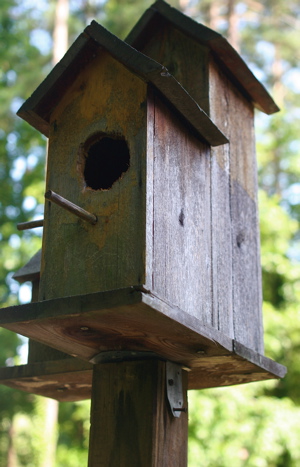- Bird Accessories, Bird Houses, Blue Bird Houses, Bluebird Houses, Decorative Bird Houses, Uncategorized, Wood Birdhouse
Got Squirrel Damage to Blue Bird Houses?
Okay…so this may not be a bluebird house, but it does represent a typical squirrel-enlarged entrance. Has this happened to any of your birdhouses?
Early fall is the perfect time to clean birdhouses in preparation for winter. Resident birds like chickadees, titmice, and wrens will use houses to roost on cold winter nights. Our bluebirds actually stuck around and over-wintered here in North Georgia last year, so blue bird houses should also receive a thorough cleaning.
An old spatula works well to remove nesting materials, and makes the perfect scraper to remove stuck-on debris. Discard nest material away from the birdhouse, as this will likely attract predators. For the safety of your health, never breath in the dust from the nest materials either. Rubber gloves are helpful too.
To salvage an enlarged entrance and restore your birdhouses, predator guards are available. Simple metal portals work well, and fit right over the entrance, denying large birds or squirrels back inside the house. Two small nails will tack these down securely and in a jiffy! Decorative predator guards are also available, and will undo the damage done to your birdhouse.
-
Heated Bird Baths Allow Some Birds to Over-Winter
With the end of summer, so comes the migration south for many song birds. A few favorites may stick around if their habitat suits them well enough. Bluebirds in my yard for example, surprised me last year when they decided to over-winter. Probably because of the juicy live worms they were offered everyday, and mostly because of the heated bird baths in the yard. This season we had three successful broods!
Heated bird baths really are important to wild birds. As temperatures drop and local water sources tend to freeze over, the baths offer an oasis for drinking and bathing. Clean feathers are a must for birds to stay warm too. When you see them “puff up” it is a mechanism they use to retain body heat. Some folks believe birds can eat snow for water, and they can, but it takes them many calories to convert the snow to water. And these are precious calories needed to just stay warm.
If you already have a favorite bath, please don’t empty it and turn it over for winter. Consider adding a heater or deicer to it for the birds. They need fresh water in winter just as much as hot summ
er months. Many of the newer heaters are safe for use with all bird baths, so there’s no worry about having a metal heater in a plastic or resin bath. The Heated Rock for example, is an innovative new heater that’s safe with all types of baths. Mat-type heaters can be used with all baths as well.
Help birds to thrive and flourish this winter by offering a consistent fresh water source with heated bird baths. You never know who may surprise you and decide to stick around?
-
Bird Baths Handcrafted the Old Fashioned Way
Want to entice more feathered friends? Better than any birdhouse or bird feeder, bird baths really do the trick. Fresh water is very appealing to many species, even those who may never visit a feeder or use a birdhouse.The water element is in fact the most crucial one when creating a wildlife habitat.
If you fancy the nicer things in your garden, there are pedestal type bird baths that are still crafted the old fashioned way by talented artisans. Fine clays are used to create elegant designs, many are even hand painted. The Best Friends Bird Bath shown at left features an intricate relief of cats and dogs. The character is charming, and you can be sure birds will love it too! With a patented locking lid system for added stability, this bath will last for many seasons of use.
Although the production methods differ significantly they share certain features – an emphasis on quality, craftsmanship, and attention to detail, offering beautiful, American-made bird baths and garden decor.





